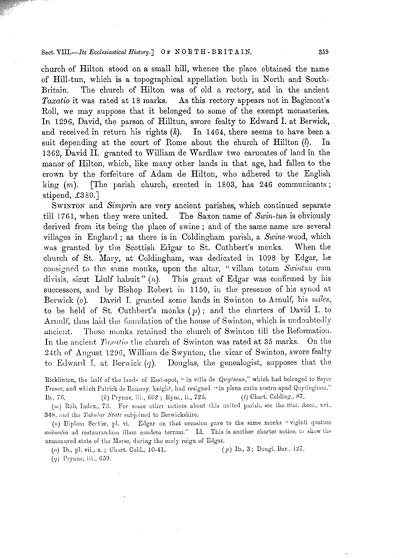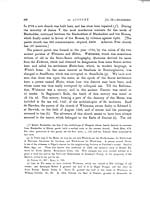Volume 3
(371) Page 359
Download files
Individual page:
Thumbnail gallery: Grid view | List view

359 church of Hilton stood on a small hill, whence the place obtained the name of Hill-tun, which is a topographical appellation both in North and South- Britain. The church of Hilton was of old a rectory, and in the ancient Taxatio it was rated at 18 marks. As this rectory appears not in Bagimont's Roll, we may suppose that it belonged to some of the exempt monasteries. In 1296, David, the parson of Hilltun, swore fealty to Edward I. at Berwick, and received in return his rights (k). In 1464, there seems to have been a suit depending at the court of Rome about the church of Hillton (l). In 1362, David II. granted to William de Wardlaw two carucates of land in the manor of Hilton, which, like many other lands in that age, had fallen to the crown by the forfeiture of Adam de Hilton, who adhered to the English king (m). [The parish church, erected in 1803, has 246 communicants; stipend, �380.] SWINTON and Simprin are very ancient parishes, which continued separate till 1761, when they were united. The Saxon name of Swin-tun is obviously derived from its being the place of swine ; and of the same name are several villages in England ; as there is in Coldingham parish, a Swine-wood, which was granted by the Scottish Edgar to St. Cuthbert's monks. When the church of St. Mary, at Coldingham, was dedicated in 1098 by Edgar, he consigned to the same monks, upon the altar, " villain totam Swintun cum divisis, sicut Liulf habuit" (n). This grant of Edgar was confirmed by his successors, and by Bishop Robert in 1150, in the presence of his synod at Berwick (o). David I. granted some lands in Swinton to Arnulf, his miles, to be held of St. Cuthbert's monks (p) ; and the charters of David I. to Arnulf, thus laid the foundation of the house of Swinton, which is undoubtedly ancient. Those monks retained the church of Swinton till the Reformation. In the ancient Taxatio the church of Swinton was rated at 35 marks. On the 24th of August 1296, William de Swynton, the vicar of Swinton, swore fealty to Edward I. at Berwick (q). Douglas, the genealogist, supposes that the Ricklinton, the half of the lands of East-spot, " in villa de Qwytsoun," which had belonged to Seyer Fraser, and which Patrick de Ramsay, knight, had resigned "in plena curia nostra apud Quytingham." Ib., 76. (k) Prynne, iii., 662 ; Rym., ii., 725. (l) Chart. Colding., 87. (m) Rob. Index., 73. For some other notices about this united parish, see the Stat. Acco., xvi., 348, and the Tabular State subjoined to Berwickshire. (n) Diplom Scoti�, pl. vi. Edgar on that occasion gave to the same monks " viginti quatuor animalia ad restaurandam illam eandem terrain." Id. This is another charter notice, to show the unmanured state of the Merse, during the early reign, of Edgar. (o) Ib., pl. vii., x. ; Chart. Cold., 10-41. (p) Ib., 3; Dougl. Bar., 127. (q) Prynne, iii., 659.
Set display mode to:
![]() Universal Viewer |
Universal Viewer | ![]() Mirador |
Large image | Transcription
Mirador |
Large image | Transcription
Images and transcriptions on this page, including medium image downloads, may be used under the Creative Commons Attribution 4.0 International Licence unless otherwise stated. ![]()
| Caledonia, or, An account, historical and topographic of North Britain from the most ancient to the present times > Volume 3 > (371) Page 359 |
|---|
| Permanent URL | https://digital.nls.uk/74528816 |
|---|---|
| Description | Vol. III. |
|---|---|
| Attribution and copyright: |
|

